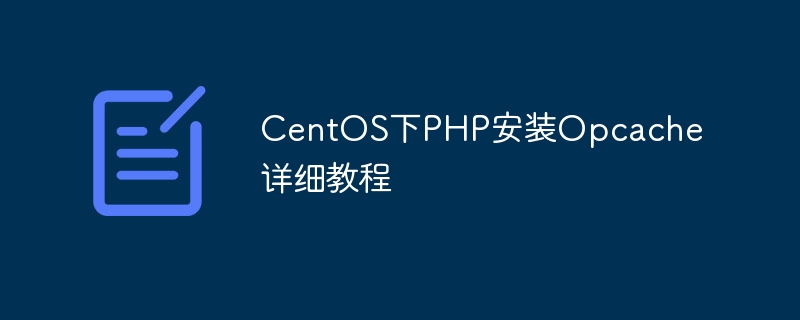Detailed tutorial on installing Opcache with PHP under CentOS

Detailed Tutorial on Installing Opcache in PHP under CentOS
In the web development process, performance optimization is a crucial part, and excellent caching tools are the key to improving website performance an effective way. In PHP development, Opcache is a very popular PHP code caching tool that can significantly improve the performance of PHP applications. This article will introduce in detail how to install and configure PHP Opcache on CentOS systems to improve website performance and response speed.
Step 1: Install PHP
First, make sure PHP is installed on the CentOS system. You can use the following command to view the PHP version installed in the system:
php -v
If PHP is not installed, you can use the following command to install it:
yum install php
Step 2: Install the Opcache extension
- In the CentOS system, you can install the Opcache extension through the yum tool:
yum install php-opcache
- After the installation is complete, you need to edit the PHP configuration file php.ini and add The following content enables the Opcache extension:
[opcache] zend_extension=opcache.so opcache.enable=1 opcache.enable_cli=1 opcache.memory_consumption=128 opcache.interned_strings_buffer=8 opcache.max_accelerated_files=10000 opcache.revalidate_freq=2 opcache.fast_shutdown=1 opcache.enable_file_override=1 opcache.save_comments=0
- After editing, save and exit the editor, and restart the Apache server to apply the new configuration.
systemctl restart httpd
Step 3: Verify whether Opcache is installed successfully
You can create a phpinfo.php file containing the following content:
<?php phpinfo(); ?>
Put This file is placed in the root directory of the website and accessed in the browser. You can search for the "OPcache" keyword in the output information to verify whether Opcache has been successfully installed and enabled.
Step 4: Optimize the configuration
In addition to the basic configuration, you can also optimize the Opcache configuration parameters according to the actual situation to further improve performance. Parameters such as memory consumption and the number of cached files can be adjusted according to actual needs to adapt Opcache to the characteristics and needs of the current application.
Summary
Through the above steps, you can successfully install and configure the PHP Opcache extension on your CentOS system, thereby significantly improving the performance and response speed of your PHP applications. Remember to conduct adequate testing before making configuration changes to your production environment to ensure that the new configuration will not have a negative impact on the system. I hope this article is helpful to you, and I wish you good luck with your website performance optimization!
The above is the detailed content of Detailed tutorial on installing Opcache with PHP under CentOS. For more information, please follow other related articles on the PHP Chinese website!

Hot AI Tools

Undresser.AI Undress
AI-powered app for creating realistic nude photos

AI Clothes Remover
Online AI tool for removing clothes from photos.

Undress AI Tool
Undress images for free

Clothoff.io
AI clothes remover

AI Hentai Generator
Generate AI Hentai for free.

Hot Article

Hot Tools

Notepad++7.3.1
Easy-to-use and free code editor

SublimeText3 Chinese version
Chinese version, very easy to use

Zend Studio 13.0.1
Powerful PHP integrated development environment

Dreamweaver CS6
Visual web development tools

SublimeText3 Mac version
God-level code editing software (SublimeText3)

Hot Topics
 CakePHP Project Configuration
Sep 10, 2024 pm 05:25 PM
CakePHP Project Configuration
Sep 10, 2024 pm 05:25 PM
In this chapter, we will understand the Environment Variables, General Configuration, Database Configuration and Email Configuration in CakePHP.
 PHP 8.4 Installation and Upgrade guide for Ubuntu and Debian
Dec 24, 2024 pm 04:42 PM
PHP 8.4 Installation and Upgrade guide for Ubuntu and Debian
Dec 24, 2024 pm 04:42 PM
PHP 8.4 brings several new features, security improvements, and performance improvements with healthy amounts of feature deprecations and removals. This guide explains how to install PHP 8.4 or upgrade to PHP 8.4 on Ubuntu, Debian, or their derivati
 CakePHP Date and Time
Sep 10, 2024 pm 05:27 PM
CakePHP Date and Time
Sep 10, 2024 pm 05:27 PM
To work with date and time in cakephp4, we are going to make use of the available FrozenTime class.
 CakePHP File upload
Sep 10, 2024 pm 05:27 PM
CakePHP File upload
Sep 10, 2024 pm 05:27 PM
To work on file upload we are going to use the form helper. Here, is an example for file upload.
 CakePHP Routing
Sep 10, 2024 pm 05:25 PM
CakePHP Routing
Sep 10, 2024 pm 05:25 PM
In this chapter, we are going to learn the following topics related to routing ?
 Discuss CakePHP
Sep 10, 2024 pm 05:28 PM
Discuss CakePHP
Sep 10, 2024 pm 05:28 PM
CakePHP is an open-source framework for PHP. It is intended to make developing, deploying and maintaining applications much easier. CakePHP is based on a MVC-like architecture that is both powerful and easy to grasp. Models, Views, and Controllers gu
 How To Set Up Visual Studio Code (VS Code) for PHP Development
Dec 20, 2024 am 11:31 AM
How To Set Up Visual Studio Code (VS Code) for PHP Development
Dec 20, 2024 am 11:31 AM
Visual Studio Code, also known as VS Code, is a free source code editor — or integrated development environment (IDE) — available for all major operating systems. With a large collection of extensions for many programming languages, VS Code can be c
 CakePHP Creating Validators
Sep 10, 2024 pm 05:26 PM
CakePHP Creating Validators
Sep 10, 2024 pm 05:26 PM
Validator can be created by adding the following two lines in the controller.






